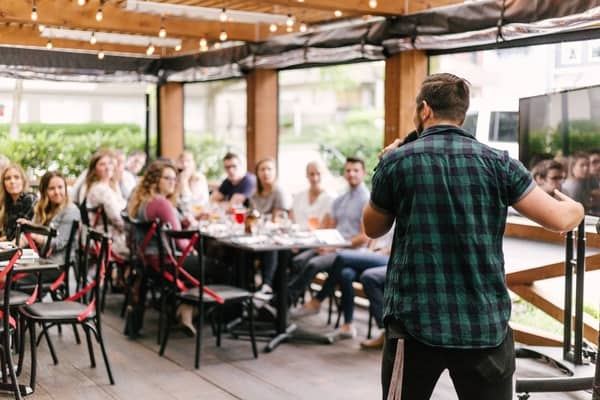Media relations
Media roundtable: A simple planning guide
The media roundtable format is a key part of the PR armoury but, to my mind, it’s used too little.
This piece covers the whys and wherefores of planning a successful media roundtable.
A PR agency or in-house PR team should lead on these activities but it’s helpful for other stakeholders to understand key considerations for getting it to work.
So, let’s start off with the basics…
What is a media roundtable?
Definitions can vary so, for the purposes of getting everyone on the same page, this is how I see the format.
Essentially, it’s a structured but discursive conversation between subject matter experts. Attendees typically sit around a table – see what they did there? – to facilitate the flow of conversation.
They will typically be chaired by an impartial subject matter expert who is tasked with managing the flow of conversation by keeping everyone on topic and on time.

And, of course, there will be journalists in the room too. They will be documenting the discussion and, in some instances, contributing questions as the various perspectives around the table becomes clear.
When should you consider a media roundtable?
While I’m a huge advocate of the roundtable tactic, it’s not the right format for every media story.
If, for example, you want to secure broad coverage for a story then it’s not going to deliver. However, if you’re focused on defined audiences or want to tackle a specific theme in detail, a media roundtable is ideal.
Keep the desired outcome front and centre of your thinking when considering whether it’s the right approach.
Planning a successful media roundtable
Once you’ve decided that it’s the right tactic, the real work begins. Here are some of the key consideration you need to factor in.
Decide on your theme
The roundtable is not a format to discuss product features and service capabilities. It’s the place to discuss topics and issues which are typically affecting your industry or the work of your customers. You’re not there to sell. You’re there to provide opinion and enable conversations.
Your first port of call in the planning process is to set the theme of the session. To do that effectively, you need to avoid going to broad. Find a specific theme.
For example, rather than the impact of compliance on IT, identify specific pieces of compliance that matter to your prospects. Focus on an area of tech relevant to your business, then drill down to a specific vertical or horizontal market.
You may even want to address the issue in a particular geographical region. Or maybe it’s people in certain roles within an industry that matter most to you.
Throughout the process, keep your target audience and the outcomes you want to drive at the heart of every decision.
Structure and dynamics in the room
Balance and credibility are the two most important elements you can control here.
Attendees will be a blend of your company, third party experts, customers, possibly tech partners and, of course, journalists.
In total, aim to have five or six participants in total, excluding media invitees which we’ll come onto shortly.
- Include one or two representatives from your organisation. Preferably they’ll be plain talking senior team members with a keen understanding of the subject.
- Invite one or two customers with relevant knowledge and opinions too. This brings related but distinct opinions into the room and gives it more credibility too.
- Add further weight to your credibility by including an independent third-party expert, such as an industry analyst or commentator.
- Consider involving a technology partner too but don’t make them a stooge. The discussion needs catalysts, not pacifiers!
You also need to be clear on who is chairing the session. There’s no hard rule about who should take this role, but gravitas and control of the room help hugely.
Often it makes sense to invite an experienced and well-known journalist to pick up the responsibility. Their independence lends the discussion more credibility. However, any form of independent moderator can be considered.
When it comes to your media attendees, two things matter. Firstly, you need to identify the most relevant journalists in the room. Your chosen theme will determine who they are and which publications they represent.
The next is the number of media attendees you’re involving. If you have too few, it’s a missed opportunity. Too many, and it becomes unwieldy to manage the flow of conversation and key points are likely to be missed.
As an example, if I organised a roundtable of six experts, I’d six to eight journalists in the room, maximum.
Get the right time and the right place
The location of the roundtable is key. Make it easy for everyone to get to and it’s infinitely easier to get great people there. For example, if your topic is in the financial sector, choose somewhere near a financial district, like the City of London or Bank.
And don’t forget attendees need to get to work after the event too.
Scout the venue for travel links, space, facilities and external noise to make sure it’s a great fit. If required, offer to cover transport arrangements for everyone involved.

On that point, starting early also makes a big difference. A breakfast session gets journalists involved before the day’s editorial agenda has a chance to take them away from you.
Late in the day can feel less formal, but it means you’ve a greater risk of people dropping out. Keep the this in mind when you’re constructing your plans.
Whatever the time of day, keep a tight agenda (maximum of 90 minutes) to ensure all key points are covered. There’s no worse feeling than running out of time with plenty of ground left to cover!
For both media and spokespeople, leave no stone un-turned. Check in to make sure they’re OK getting to the venue and support them if any issues crop up.
Prepare to share
Thorough spokespeople briefing is vital. Prepare notes on the structure and format so everyone knows what to expect in advance. This gives them time to plan questions they would like to raise at the table.
Create discussion documents to detail key talking points for spokespeople. Don’t make it a script but give pointers to help them structure their responses and conversations.
Soundbites and key take outs are arguably the most useful consideration here. Providing biographies of fellow attendees, relevant articles from attending media, etc. can all be really helpful too.

Create a clear plan for capturing and sharing content from the day. It extends the reach of the activity beyond the media in the room, provided it’s appropriate for sharing. For example, do you want to encourage live tweeting of the event or are there confidentiality restrictions to consider? Or do you want to film it for a highlights reel? Maybe it’s viable to run a live stream – providing the Wifi connection will hold up.
Keep your audience front of mind to ensure your investment is put in the right places.
One final key thing is to capture the audio of the session as well as taking notes of the key talking points. These can be helpful in facilitating follow up conversations.
Don’t forget the de-brief
Gather the information and insights that come from the media roundtable into a de-briefing document for your key stakeholders.
It boosts their engagement with the event and also gives them the warts and all view of the conversations that took place.
In my experience, this can be as useful as reading the media coverage itself.
